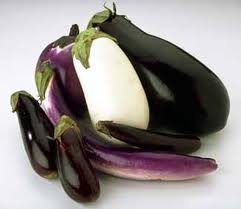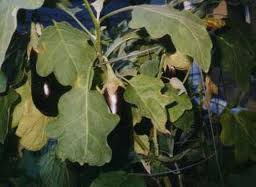 Eggplant was so named because the first varieties introduced to English-speaking people had egg-shaped fruits. Its scientific name is Solanum melongena var. esculentum.
Eggplant was so named because the first varieties introduced to English-speaking people had egg-shaped fruits. Its scientific name is Solanum melongena var. esculentum.
The eggplant is probably a native of India and has been cultivated for a long time. It is a member of the nightshade family, making it a close relative of the tomato, pepper and potato. As with all nightshade plants, eggplant should not be located near any black walnut trees. They exude a chemical that is harmful to nightshade plants.
The eggplant is a very tender plant that requires a long, warm season for successful production. The plants are injured by long periods of chilly, frostless weather in the spring, and are killed by a light frost. Plants should not be set out until all danger of frost has passed.
What Eggplant Looks Like
 Eggplant leaves are large, alternate and lobed, with the underside of most cultivars (varieties) covered with dense wool-like hairs. The flowers are violet-colored and star-shaped, and bloom either as a solitary or in clusters of two or more. These characteristics give the plant an ornamental look (it looks good in a flower bed). The fruit can vary in shape from oval to round and long to oblong. The color of the mature fruit is typically purple to purple-black, but can also be red, yellowish-white, white or green.
Eggplant leaves are large, alternate and lobed, with the underside of most cultivars (varieties) covered with dense wool-like hairs. The flowers are violet-colored and star-shaped, and bloom either as a solitary or in clusters of two or more. These characteristics give the plant an ornamental look (it looks good in a flower bed). The fruit can vary in shape from oval to round and long to oblong. The color of the mature fruit is typically purple to purple-black, but can also be red, yellowish-white, white or green.
Environmental Preferences for Eggplant
Light: full sun; at least 8 hours a day
Soil: well-drained, high organic matter
pH: 6.0-7.0
Preferred Temperature: warm (70 degrees - 85 degrees F)
Moisture Requirements: average
How Many Eggplants To Plant
The average yield of eggplant varies with the variety planted and the growing conditions. Two or three plants per family member who likes eggplant is usually sufficient. Once eggplants begin to produce fruit and they are kept picked, they continue to produce pretty much to first frost.

